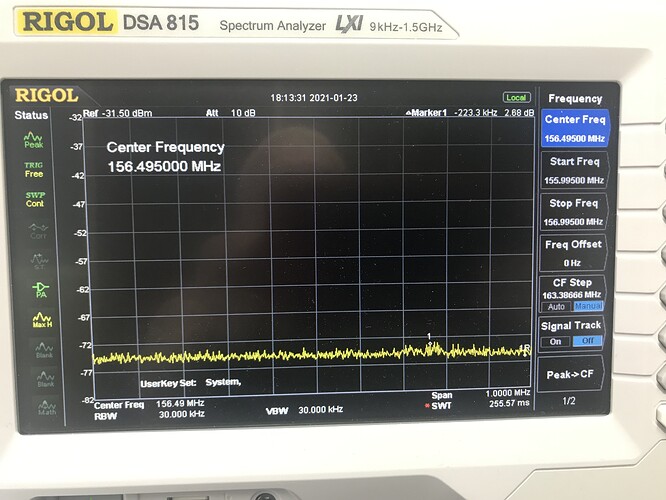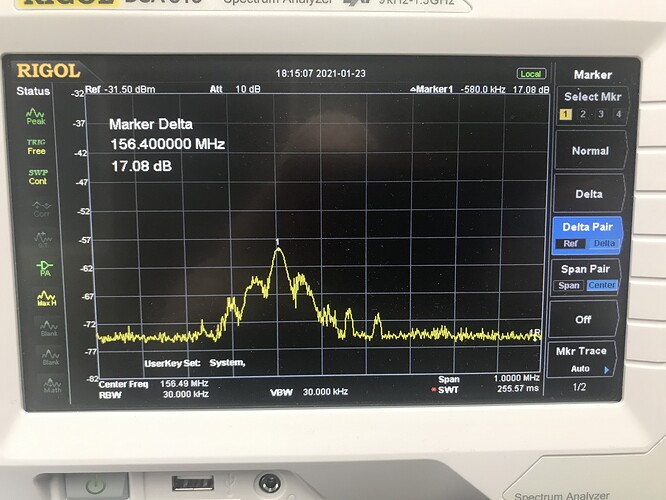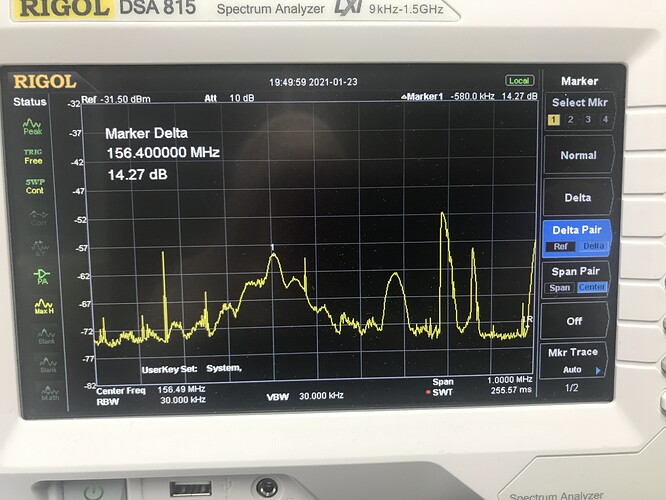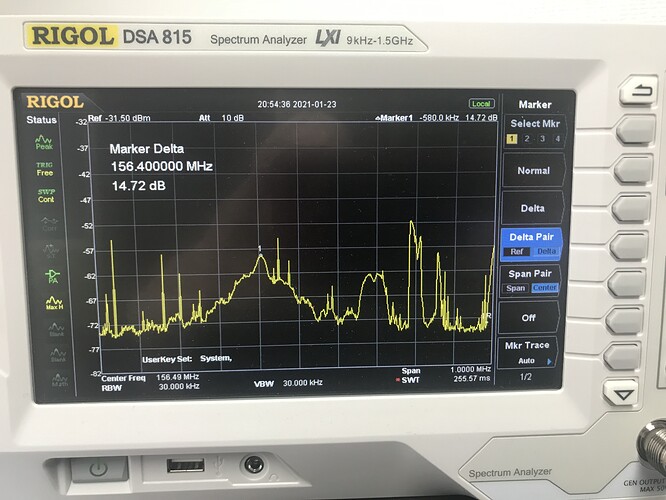In my office marine band - where I spend a bit of time and monitor often has wide band noise, making the squalech open and weaker stations impossible to hear. I came in this morning (Saturday) at 8.30 and turning on the radios (a scanner and a marine set) noticed all was very quiet, so having some time spare, I put the analyser on, with an antenna plugged into it and set it to peak hold and left it looking at just 156.0 to 157.0MHz the results over a few hours were interesting. at arund 10.20, the wide band noise started, centred at 156.4MHz but there’s nothing there - no interference or buzzes, just an increase in background, with some peaks either side. As the usual marine stuff gets going you can see that chat channels are getting used, and many I think are older wide band radios as they spread considerably, but there are also quite a few very narrow spikes. Here are the photos taken at intervals - see what you can conclude? Paul
Since you monitor a lot, you’ve probably got a good idea of the inherent background noise level due to the usual QRM suspects.
So discounting those in direct terms and noting your mention of old gear out there in Marine use (and elsewhere LMR) that’s still technically in spec emissions wise -
One very real possibility, especially if notable instances of QRM increase happens during sending periods, is some of the older gear could be suffering from induced pickup of digital EM from the surroundings and either directly repeating them or the emissions induced creating FSK shifts during voice/phone silences where there’s an effectively empty carrier.
Now given the Tx output of maritime vhf gear being upwards of 20W (25 was typical back when I kept track) it would act as a pretty good wide range unintended repeater if accidentally passing square and sawtooth induced emissions into the RF oscillator or more likely the post multiplier stages of the RF chain, so the BPF’s are still passing the unwanted in-frequency and in-band emissions of the Tx because they are effectively FSK only really of a notable order when the carrier is empty.
Now add in vox PTT, and it starts to get even more a pit of vipers unless there’s a pretty solid audio BPF governing the frequency and passed levels that can trigger the VOX.
Add in the fact that there’s a lot of older gear that pre-dates most of the later hi-tech instrumentation of modern vessels (remembering the digital instrumentation has its own emissions too) and digital based and/or mode signalling systems used for geo-loc tracking and their routine ‘phone home’ interval sends to reconfirm their network presence, and subsequently the kind of filtering and EMC immunity most modern high-grade gear should have is missing by virtue of age and design, the scope for the older gear being an unintentionally partner in crime to what has become a QRM minefield full of unclean digital emissions, they could easily be a big contributor and through no direct fault of owners or the consideration of what mattered when they were designed and optimised in their day.
I mean, as a precaution, my older gear each has a slot in a pigeon holes rack in an effectively Faraday cage to compensate between some being pre-digital PLL and some early digital PLL and later analogue digital circuitry based analogue modes design. So offering a bit of extra inter-equipment immunity and to help reduce an inherent adjacent active gear emmision induction into the on-air gear in use.
Some of that was purely precautionary, some because some items were questionably not so pre-RF EM clean but a mere consequence of age of design.
Talking of which, reminds me of the time a friend had hideous QRM on his airband scanner and it transpired it was a forgotten crappy 26 MHz SIG source that had accidentally got fired up causing it (harmonically) and given the Bremi item was more QRM source than usable back in it’s day, it was double hellspawn nasty in the context of my friend’s monitoring setup. Just imagine what it could have done if an older piece of TxCr gear had been used or anything Tx capable for that matter?
It’s that kind of consequential not always intended QRM causing or contributing stuff that is why I’m so hard nosed intolerant of GPIO-pin based RF sources and suchlike, because owners/users tend to have zero idea of the scope of QRM and subsequent effects they cause.
So, in short, what you’re seeing could easily be a result of the cascade of digital emissions getting regenatively repeated by older RF gear and possibility the less immune recent stuff.
20-odd Watts, especially with unity gain or better vertical antennas, makes for a very rich field density and add in regenative FSK emissions echoing induced digital emissions around the Tx and there’s a huge scope for the crappy garbage emmissions.
Not sure I agree. the characteristic display of FM transmitters with digital interference is capped by the filtering in the output so you see a fairly normal standard channel occupied display - the older radios still out there on marine band from the 50KHz channel spacing days - typically the Sailor range of products just have a wider bell curve looking display. In addition, any tunable radio reveals a noise as they are tuned across them. The noise source in my area is centred on 156.4Mzh, and extends out, with two peaks - but there is nothing detectable on any narrow band radio - which in marine is of course still 25KHz - but even sweeping a 12.5KHz spaced radio from 156 to 156.8 reveal no detectable discrete channel usage of any kind, just an elevated noise floor - which of course conceals any weak normal transmissions at the lower end if the band. In addition, the noise seems to simply appear and remain, so is not linked to a normal TX/RX cycle that would come from a 2-way radio. I’ve got an RF Explorer somewhere in the workshop and I also have a 3 element VHF beam if I can find it. Next time I am allowed to do my daily exercise, I might take a stroll and see if I can find the source. I did wonder when I first noticed the noise if it was a local cellphone installation that was the cause, but they would be there 24/7 and not starting suddenly on a Saturday morning, presumably when somebody gets to work and switches things on. It will be a bit of a quest I suspect, but I am on the edge of a marine industrial area, so it could well be one of the marine workshops. I’ve got on the display some rather narrow spikes, which are probably accidental PTT prods with no modulation component, a few very wide ones, and some fairly normal looking ones - just the weird 400 centred one that is causing me issues.
Well, in my experience the potential inadvertantly carrying some localised digital em, by some analogue gear isn’t entirely off the list - even if it’s a very low probability. Let’s not forget there is also a proportion of older gear still used by some that’s easily no longer up to spec (as in TA requirements regarding immunity and subsequently passing it on Tx) but because the gear never got condemned (because often it was fitted and never serviced/tested incrementally as regs may require) it could still be part of the problem during it’s occasional usage.
But that’s really, as far as what you witnessed, more of an consequential unwilling ‘partner in crime’ contribution than the main cause or causes.
Whilst it’d be easy to write off the potential for it being the result of experimental stuff (which is then probably off the prescribed frequencies for the Marine VHF segments for such), not all ‘experimental’ stuff people mess with is legit permitted with the experimental part of the allocation or legit on any level.
I mean, what with DDS modules at tuppence ha’penny costs and lousy how-to articles from makers and the amateur and not so amateur IOT crowd and GPIO pin pirates, the scope for some intentional and unintentional EM around in and around 156 MHz isn’t entirely off the list.
I mean, the folks who typically play with such stuff as curious tinkerer ‘makers’ with little commitment to quality wouldn’t know what a BPF is, let alone do any kind of suppression efforts. So whether you’re talking out-of-band emmision (from lower harmonically related VHF ISM frequencies) or misused in-band using unauthorized use of DDS modules using 156 MHz or badly tweaked VHF IOT modules intentionally outputing on the segment by user design, there’s a huge wide field of possibility.
It’s also worth noting that a lot of so-called certified ‘smart’ devices used by the Utility’s aren’t really all that out-of-band clean when they phone home or get near-field activated deliberately.
Lastly, let’s not forget the quasi-aspect everyone seems to overlook - that when you have a high amount of RF use, in polarity or otherwise, there’s a tendency for a mixer effect to occur, so two or more emmisions that happen to meet can end up causing some degree of subsequently produced (low order in most cases) product, divided, difference and additive wavelength emmision. Remember that such stray latent products aren’t being taken out by BPF/LPF/HPF in gear if they are partially or well within the pass bands or harmonics of equally.
When it comes to stray EM potential from digital sourced, oscillators by design or consequentially by other digitally switching or signal synthesis such as PLL type control/governing, it’s a ■■■■■■ minefield to go trying to diagnose and clean up/resolve.
Notably, I don’t allow anyone else’s (speaking of pre-LD) digital gear not specifically used with my radio gear anywhere near my gear and enforced with extreme prejudice when I’m on air. Even the stuff that I use has been worked over to minimise it’s subsequent EM to crazy extremes, but given the QRM these days, nobody wants additional localised added QRM just because they were too lazy and left a powered up cellphone next to their TxCr.
But even if none of the above are actual or contributing candidates, it shows how wide a scope there is for mystery sources way beyond those areas I highlighted previously and in this topic.
It’s actually a shame I can’t see it first hand as for interest or practice sake, it’s an interesting example in a frequency segment I’ve not had much call (beyond merely a legit user rarely back in the day) to work with beyond workshop diagnosis/eval of ex units for mod/fishgut purposes (for example, some ■■■■■■ nice casings and structural chassis were used in MB gear).
Well good luck with your curiosity quest and maybe you’ll either discover the actual cause or stumble on it inadvertently (amazing how many times it’s inadvertently found).



